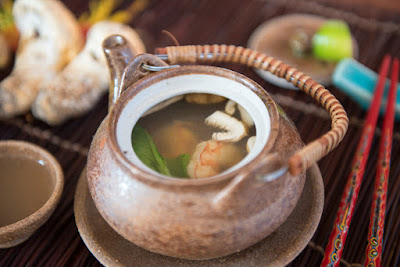THE BLACK TRUMPET (Craterellus sp.) is one my favorite wild mushrooms for the table. Like its cousins in the chanterelle family, it's earthy with a touch of fruity sweetness. On the West Coast, most pickers look for them in the coastal hills of northern California and southern Oregon, where they hide among the leaf litter of forests dominated by Douglas fir, tanoak, and madrone (with a smattering of decayed redwood for good measure). But they can be found elsewhere...
One of the great pleasures of mushroom hunting is sleuthing out the many clues that lead to a full basket. The black trumpet is one of those varieties that requires putting on your detective cap and paying serious attention to the landscape. Cracking the case results in a righteous dinner.
Creamy Polenta with Wild Mushrooms
This recipe is adapted from a New York Times recipe by Sam Sifton, who rightly points out that soy sauce and butter make a heavenly combination, particularly in service to fungi, because of the massive umami factor.
Many home cooks view polenta with trepidation. It doesn't follow directions! Don't be afraid. Polenta is easy and forgiving, even if temperamental—and a perfect vehicle for wild mushrooms. Yes, it rarely cooks the same way twice, varying by brand, weather, elevation, and seemingly by whim. Just add more liquid if necessary and adjust seasoning, cheese, and butter to taste.
This makes a side dish for two. I used a mixture of golden chanterelles and black trumpets.
For polenta:
1 cup water (plus more as it cooks)
1/2 cup milk
1/2 cup polenta
1/2 tsp salt
1 tbsp butter
Parmesan cheese, grated (optional)
For mushrooms:
1/4 lb (or more) wild mushrooms, roughly cut into pieces
2 tbsp butter, divided
2 cloves garlic, minced
2 tbsp porcini powder*, rehydrated with 1/2 cup hot water
1 tbsp soy sauce
1 tbsp heavy cream
1 tsp olive oil
Salt and pepper
* You can pulverize a store-bought package of dried porcini into powder with a spice grinder. I make jars of the stuff from my #3 mature king boletes to use with rubs and in sauces, stews, and soups. No porcini? Substitute with chicken or vegetable stock.
1. Over medium-high heat, bring water and milk to simmer in a medium-sized sauce pan or pot. Slowly add polenta while whisking to prevent clumping. Season with salt and continue to whisk for a minute or two. Turn heat to low and cook for about 45 minutes, stirring occasionally. Add more water as necessary to maintain creaminess.
2. Meanwhile, in a small pan sauté garlic and mushrooms in a tablespoon of butter over medium heat, stirring occasionally. Cook mushrooms until they release their water and then cook off liquid, allowing mushrooms to brown slightly; this might take several minutes. Season with salt and pepper.
3. Add 1/2 cup porcini stock to mushrooms. Reduce by half and turn heat to low. Add a splash each of soy sauce and cream and a drizzle of olive oil. Stir together and allow to thicken. Keep warm in pan over low heat while waiting for polenta to cook. If sauce becomes too thick, add another splash of water, cream, or stock. Just before plating, melt one more tablespoon of butter into mushroom sauce and stir.
4. When polenta is thoroughly cooked and creamy, add butter and cheese (and more liquid if necessary). Adjust seasoning. Serve in a bowl and spoon mushrooms and sauce on top.
Serves 2 as a side dish.






























